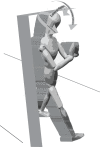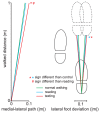Texting and walking: strategies for postural control and implications for safety
- PMID: 24465402
- PMCID: PMC3898913
- DOI: 10.1371/journal.pone.0084312
Texting and walking: strategies for postural control and implications for safety
Erratum in
- PLoS One. 2014;9(2):e91489
Abstract
There are concerns about the safety of texting while walking. Although evidence of negative effects of mobile phone use on gait is scarce, cognitive distraction, altered mechanical demands, and the reduced visual field associated with texting are likely to have an impact. In 26 healthy individuals we examined the effect of mobile phone use on gait. Individuals walked at a comfortable pace in a straight line over a distance of ∼8.5 m while; 1) walking without the use of a phone, 2) reading text on a mobile phone, or 3) typing text on a mobile phone. Gait performance was evaluated using a three-dimensional movement analysis system. In comparison with normal waking, when participants read or wrote text messages they walked with: greater absolute lateral foot position from one stride to the next; slower speed; greater rotation range of motion (ROM) of the head with respect to global space; the head held in a flexed position; more in-phase motion of the thorax and head in all planes, less motion between thorax and head (neck ROM); and more tightly organized coordination in lateral flexion and rotation directions. While writing text, participants walked slower, deviated more from a straight line and used less neck ROM than reading text. Although the arms and head moved with the thorax to reduce relative motion of the phone and facilitate reading and texting, movement of the head in global space increased and this could negatively impact the balance system. Texting, and to a lesser extent reading, modify gait performance. Texting or reading on a mobile phone may pose an additional risk to safety for pedestrians navigating obstacles or crossing the road.
Conflict of interest statement
Figures



Similar articles
-
Concurrent phone texting alters crossing behavior and induces gait imbalance during obstacle crossing.Gait Posture. 2018 May;62:422-425. doi: 10.1016/j.gaitpost.2018.04.004. Epub 2018 Apr 6. Gait Posture. 2018. PMID: 29653403 Free PMC article.
-
Dual task interference during walking: The effects of texting on situational awareness and gait stability.Gait Posture. 2015 Oct;42(4):466-71. doi: 10.1016/j.gaitpost.2015.07.060. Epub 2015 Aug 5. Gait Posture. 2015. PMID: 26298159
-
Gait Pattern Alterations during Walking, Texting and Walking and Texting during Cognitively Distractive Tasks while Negotiating Common Pedestrian Obstacles.PLoS One. 2015 Jul 29;10(7):e0133281. doi: 10.1371/journal.pone.0133281. eCollection 2015. PLoS One. 2015. PMID: 26222430 Free PMC article. Clinical Trial.
-
A narrative review of texting as a visually-dependent cognitive-motor secondary task during locomotion.Gait Posture. 2017 Feb;52:354-362. doi: 10.1016/j.gaitpost.2016.12.027. Epub 2016 Dec 22. Gait Posture. 2017. PMID: 28043057 Review.
-
Contributions to the understanding of gait control.Dan Med J. 2014 Apr;61(4):B4823. Dan Med J. 2014. PMID: 24814597 Review.
Cited by
-
Association between mobile phone use and neck pain in university students: A cross-sectional study using numeric rating scale for evaluation of neck pain.PLoS One. 2019 May 20;14(5):e0217231. doi: 10.1371/journal.pone.0217231. eCollection 2019. PLoS One. 2019. PMID: 31107910 Free PMC article.
-
Does texting while walking really affect gait in young adults?J Neuroeng Rehabil. 2015 Sep 22;12:86. doi: 10.1186/s12984-015-0079-4. J Neuroeng Rehabil. 2015. PMID: 26395248 Free PMC article.
-
Distracted mobile device use among street-crossing college student pedestrians: an observational approach.J Am Coll Health. 2022 Oct;70(7):2135-2142. doi: 10.1080/07448481.2020.1845182. Epub 2020 Dec 1. J Am Coll Health. 2022. PMID: 33258736 Free PMC article.
-
Walking stability during cell phone use in healthy adults.Gait Posture. 2015 May;41(4):947-53. doi: 10.1016/j.gaitpost.2015.03.347. Epub 2015 Apr 8. Gait Posture. 2015. PMID: 25890490 Free PMC article.
-
Phone messages affect the detection of approaching pedestrians in healthy young and older adults immersed in a virtual community environment.PLoS One. 2019 May 29;14(5):e0217062. doi: 10.1371/journal.pone.0217062. eCollection 2019. PLoS One. 2019. PMID: 31141549 Free PMC article.
References
-
- Drews FA, Yazdani H, Godfrey CN, Cooper JM, Strayer DL (2009) Text messaging during simulated driving. Human factors 51: 762–770. - PubMed
-
- Hosking SG, Young KL, Regan MA (2009) The effects of text messaging on young drivers. Human factors 51: 582–592. - PubMed
-
- Demura S, Uchiyama M (2009) Influence of cell phone email use on characteristics of gait. European Journal of Sport Science 9: 303–309.
-
- Richtel M (2010) Driven to distraction. Forget Gum. Walking and using phone is risky. New York Times: A1.
Publication types
MeSH terms
LinkOut - more resources
Full Text Sources
Other Literature Sources
Medical

